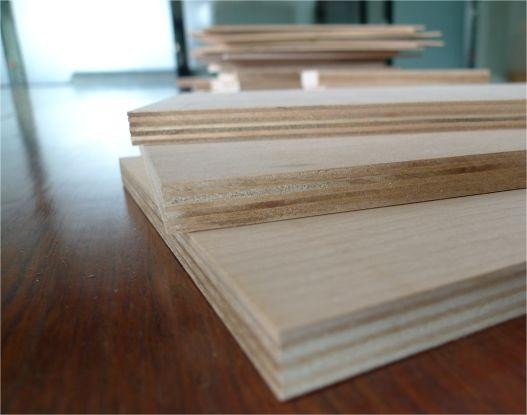Plywood is a three-layer or multi-layer board like material made by rotating and cutting wood segments into veneer or planing wood into thin wood, and then bonding with adhesive. It is usually made of odd layer veneer, and the fiber directions of adjacent layers of veneer are perpendicular to each other.
Plywood is one of the commonly used materials for furniture, one of the three major artificial panels, and can also be used as a material for airplanes, ships, trains, automobiles, buildings, and packaging boxes. A group of veneers is usually formed by gluing adjacent layers of wood grain perpendicular to each other, with the surface and inner layers symmetrically arranged on both sides of the central layer or core. A slab made by interlacing the glued veneer in the direction of the wood grain and pressing it under heating or non heating conditions. The number of layers is generally odd, and a few may have even numbers. The differences in physical and mechanical properties in the vertical and horizontal directions are relatively small. Plywood can improve wood utilization and is a major way to save wood.

The plywood specifications are: 1220 × 2440mm, while the thickness specifications generally include: 3, 5, 9, 12, 15, 18mm, etc. The main wood species include beech, camphor, willow, poplar, eucalyptus, birch, etc.
| Plywood | Odd layers | 3-13layers |
| Plywood | Characteristic | No deformation; Low shrinkage rate; Smooth surface |
| Multi-lay er plywood /laminated plywood | Usage | Ordinary plywood , decorative panels |
| Material | Timber log | Broad-leaved tree plywood; Coniferous tree plywood |
| Odd layers | Grade | Superior products; First class products; Qualified products |
| Application | Partition wall; Ceiling; Wall skirt; Facade |
Basic Principle
In order to improve the anisotropic properties of natural wood as much as possible, and to make the properties of plywood uniform and stable in shape, the structure of plywood generally follows two basic principles: firstly, symmetry; The second is that adjacent layers of veneer fibers are perpendicular to each other. The principle of symmetry requires that the veneer on both sides of the symmetrical central plane of the plywood, regardless of wood properties, veneer thickness, number of layers, fiber direction, moisture content, etc., should be symmetrical with each other. In the same plywood, single tree species and thicknesses of veneer can be used, as well as different tree species and thicknesses of veneer; But any two layers of symmetrical veneer trees on both sides of the symmetrical central plane should have the same thickness. The top and back panels are allowed to be of different tree species.
To ensure that the structure of plywood conforms to both of the above basic principles, its number of layers should be odd. So plywood is usually made into three layers, five layers, seven layers, and other odd layers. The names of each layer of plywood are: the surface layer of veneer is called surface board, and the inner layer of veneer is called core board; The front panel is called the panel, and the back panel is called the back panel; In the core board, the fiber direction parallel to the surface board is called a long core board or medium board. When forming the cavity table slab, the panel and back panel must face outward tightly..
Post time: May-10-2023
